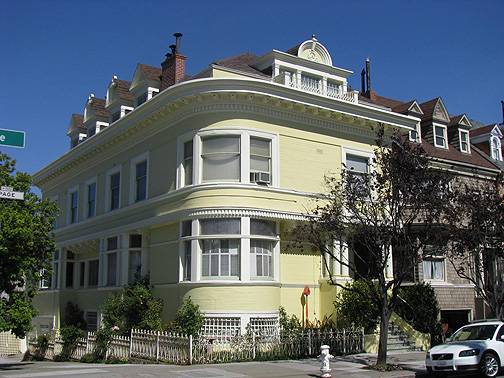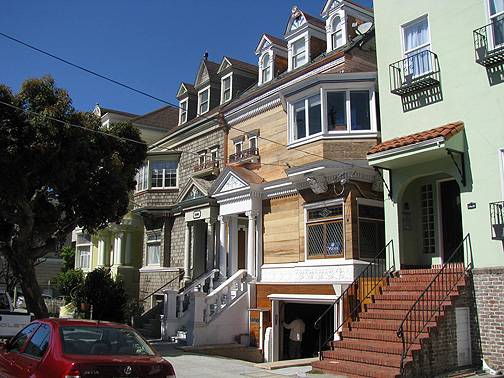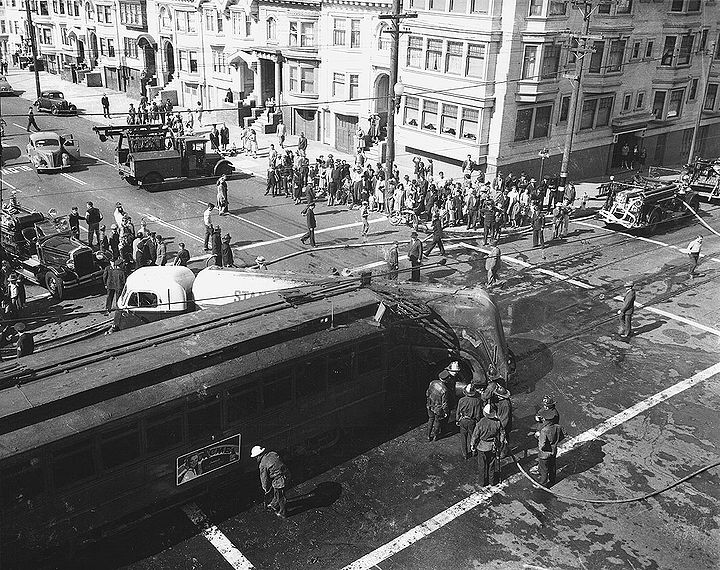Masonic from Page to Hayes: Difference between revisions
(added Peoples Wall documentary) |
(edited caption of crash photo to reflect correct date per user, added newspaper clipping to describe crash) |
||
| (2 intermediate revisions by 2 users not shown) | |||
| Line 25: | Line 25: | ||
[[Image:Hayes-and-Masonic-crash-c1930s.jpg|720px]] | [[Image:Hayes-and-Masonic-crash-c1930s.jpg|720px]] | ||
'''Hayes and Masonic streetcar crash, | '''Hayes and Masonic streetcar and gasoline truck crash, May 23,1945.''' | ||
''Photo: | ''Photo: C. R. collection'' | ||
[[Image:Masonic Hayes intersection crash May 22, 1945.png]] | |||
'''Details on the crash pictured above from the San Francisco Examiner, May 23, 1945.''' | |||
''courtesy Tana Sabatino'' | |||
<iframe src="https://archive.org/embed/PeoplesWall" width="640" | <iframe src="https://archive.org/embed/PeoplesWall" width="640" | ||
Latest revision as of 14:50, 17 May 2021
Primary Source
1482-1484 Page Street at Masonic, 2008.
Photo: Chris Carlsson
It is 1900. You have picked up the San Francisco Call from the paperboy on Masonic and Haight. You glance at the headline "Marines Invade Peking" -- a reference to U.S. efforts to undermine the Boxer Rebellion. Tucking the paper under your arm and with that eternal, wet wind at your back you make your way to your flat. The 1900 fashions serve a San Franciscan well. For women fog protection is multiple layers of corsets, petticoats, ankle-length skirts, shirtwaists, high collar blouses--all topped with a cape and broad brimmed bonnet. For men the styles dictate fewer but more substantial layers with an emphasis on wool. In any case, you are sufficiently protected to take in some of the sights and sounds of your new neighborhood.
In appearance, your neighborhood is awkward. The houses seem gangly--broad, windowless sides face vacant lots--more vacant lots than houses. In fact, on the right (south side of the block) there is not one structure (not even the seemingly ancient carriage house tucked in the alleyway). The elaborate facades of the few homes that have been built open on to a street of manure and wheel ruts--a street that, because of the absence of vehicle traffic, looks almost too wide. It is obvious that land owners anticipate further development of the block. Views of Buena Vista Park and the Panhandle are obstructed by telephone poles which have been poked into the sand up and down the street. Developers have poured sidewalks of "artstone" (an innovation in pavement which San Franciscans would later call concrete). These sidewalks and poles establish the gridiron of future streets and intersections.
If there is a beauty in the neighborhood's adolescence it derives not from sight but sound. The area enjoys that stillness that one associates with country living. There is a quietness disrupted only by occasional sounds from afar--the clank of cable cars on Haight, the vigilant bark of Park Superintendent McLaren's lame mutt at the lodge.
One such sound greets you as you pass. From the second floor window of 1482 Page, now subdivided into 1482 and 84, you discern the cry of Irma Rau, newborn daughter of Steven and Lucy. The Raus live here with Lucy's parents, Mr. and Mrs. Isaac Magnin. The Magnin's are Dutch Jews who came to San Francisco in 1878. They have established a drygoods store which has (and will continue) to prosper. Isaac has retired, leaving the business in the hands of his adult sons and stepson Stephen. Isaac built his home in 1899 (it looks in 1900 as it will look in 1980). He and his wife of 35 years live here with four of their eight children, granddaughter Irma, step-son Stephen nursemaid Maggy Kennedy and two Japanese man servants. It is obvious that the Magnins are a close family. In fact so close that Isaac has taken special measures to assure family togetherness.
1480-1478 Page Street, 2008.
Photo: Chris Carlsson
At the same time that he built his own home he also built the two adjoining houses (1478 and 1480 Page) for his two daughters. Daughter Henrietta (age 30) lives with her husband Louis Gassner, their two daughters, and two Irish maids at 1480 Page. Mr. Gassner is a furrier. The home at 1478 is not presently occupied by the Magnins. It is rented to several Japanese immigrants. The tenants work at the Magnin store.
Hayes and Masonic streetcar and gasoline truck crash, May 23,1945.
Photo: C. R. collection
Details on the crash pictured above from the San Francisco Examiner, May 23, 1945.
courtesy Tana Sabatino
<iframe src="https://archive.org/embed/PeoplesWall" width="640" height="480" frameborder="0" webkitallowfullscreen="true" mozallowfullscreen="true" allowfullscreen></iframe>
Video: courtesy Mark Freeman Films
Peoples Wall is a 22 minute documentary about the mural "Our History is No Mystery," which was created in 1976. It was on the wall of John Adams Community College at Masonic and Hayes in San Francisco, CA.
After continuing defacement--some of which was documented in the film--the mural was redesigned and repainted. Haight Ashbury Muralists: Jane Norling, Vicky Hamilin, Thomas Kunz, Miranda Bergman, Arch Williams, Peggy Tucker.
The film was made by the Haight Ashbury Film Collective, which included Mark Freeman, Claire Schoen, Jack Wilson and MJ White.




